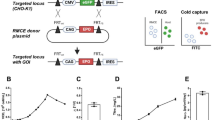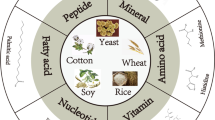Abstract
Chinese hamster ovary (CHO) cells have been widely used in the biotechnology industry for the production of therapeutic proteins, leading to various research efforts to increase the productivity of therapeutic proteins. Although the addition of small molecule enhancers in CHO cell culture can enhance productivity, it poses a problem by negatively affecting product quality. In this study, effects of 4-phenylbutyrate (4-PBA), a chemical chaperone having a positive influence on recombinant protein production in CHO cells, were investigated. By varying the timing of 4-PBA addition, it was confirmed that the titer could be increased by 1.57-fold while reducing negative effects such as growth inhibition and apoptosis, thus preserving product quality. These effects of 4-PBA demonstrate the potential of using additive for developing novel enhancers for the production of recombinant proteins and the development of strategies for CHO cell engineering.





Similar content being viewed by others
References
Jayapal KP, Wlaschin KF, Hu WS et al (2007) Recombinant protein therapeutics from CHO cells—20 years and counting. Chem Eng Prog 103:40–47
Bandaranayake AD, Almo SC (2014) Recent advances in mammalian protein production. FEBS Lett 588:253–260. https://doi.org/10.1016/j.febslet.2013.11.035
Tihanyi B, Nyitray L (2020) Recent advances in CHO cell line development for recombinant protein production. Drug Discov Today Technol 38:25–34. https://doi.org/10.1016/j.ddtec.2021.02.003
Kim JY, Kim YG, Lee GM (2012) CHO cells in biotechnology for production of recombinant proteins: current state and further potential. Appl Microbiol Biotechnol 93:917–930. https://doi.org/10.1007/s00253-011-3758-5
Li F, Vijayasankaran N, Shen AY et al (2010) Cell culture processes for monoclonal antibody production. MAbs 2:466–479. https://doi.org/10.4161/mabs.2.5.12720
Wulhfard S, Baldi L, Hacker DL et al (2010) Valproic acid enhances recombinant mRNA and protein levels in transiently transfected Chinese hamster ovary cells. J Biotechnol 148:128–132. https://doi.org/10.1016/j.jbiotec.2010.05.003
Fomina-Yadlin D, Mujacic M, Maggiora K et al (2015) Transcriptome analysis of a CHO cell line expressing a recombinant therapeutic protein treated with inducers of protein expression. J Biotechnol 212:106–115. https://doi.org/10.1016/j.jbiotec.2015.08.025
Allen MJ, Boyce JP, Trentalange MT et al (2008) Identification of novel small molecule enhancers of protein production by cultured mammalian cells. Biotechnol Bioeng 100:1193–1204. https://doi.org/10.1002/bit.21839
Backliwal G, Hildinger M, Kuettel I et al (2008) Valproic acid: a viable alternative to sodium butyrate for enhancing protein expression in mammalian cell cultures. Biotechnol Bioeng 101:182–189. https://doi.org/10.1002/bit.21882
Chen F, Kou T, Fan L et al (2011) The combined effect of sodium butyrate and low culture temperature on the production, sialylation, and biological activity of an antibody produced in CHO cells. Biotechnol Bioprocess Eng 16:1157–1165. https://doi.org/10.1007/s12257-011-0069-8
Durocher Y, Butler M (2009) Expression systems for therapeutic glycoprotein production. Curr Opin Biotechnol 20:700–707. https://doi.org/10.1016/j.copbio.2009.10.008
Jiang Z, Sharfstein ST (2008) Sodium butyrate stimulates monoclonal antibody over-expression in CHO cells by improving gene accessibility. Biotechnol Bioeng 100:189–194. https://doi.org/10.1002/bit.21726
Kumar N, Gammell P, Clynes M (2007) Proliferation control strategies to improve productivity and survival during CHO based production culture: a summary of recent methods employed and the effects of proliferation control in product secreting CHO cell lines. Cytotechnology 53:33–46. https://doi.org/10.1007/s10616-007-9047-6
Yang WC, Lu J, Nguyen NB et al (2014) Addition of valproic acid to CHO cell fed-batch cultures improves monoclonal antibody titers. Mol Biotechnol 56:421–428. https://doi.org/10.1007/s12033-013-9725-x
Jeon MK, Lee GM (2007) Correlation between enhancing effect of sodium butyrate on specific productivity and mRNA transcription level in recombinant Chinese hamster ovary cells producing antibody. J Microbiol Biotechnol 17:1036–1040
Kim NS, Lee GM (2000) Overexpression of bcl-2 inhibits sodium butyrate-induced apoptosis in Chinese hamster ovary cells resulting in enhanced humanized antibody production. Biotechnol Bioeng 71:184–193. https://doi.org/10.1002/1097-0290(2000)71:3%3c184::aid-bit1008%3e3.0.co;2-w
Welch WJ, Brown CR (1996) Influence of molecular and chemical chaperones on protein folding. Cell Stress Chaperones 1:109–115. https://doi.org/10.1379/1466-1268(1996)001%3c0109:iomacc%3e2.3.co;2
de Almeida SF, Picarote G, Fleming JV et al (2007) Chemical chaperones reduce endoplasmic reticulum stress and prevent mutant HFE aggregate formation. J Biol Chem 282:27905–27912. https://doi.org/10.1074/jbc.M702672200
Kubota K, Niinuma Y, Kaneko M et al (2006) Suppressive effects of 4-phenylbutyrate on the aggregation of Pael receptors and endoplasmic reticulum stress. J Neurochem 97:1259–1268. https://doi.org/10.1111/j.1471-4159.2006.03782.x
Lim JH, Cha HM, Han HJ et al (2019) Evaluating the impact of suramin additive on CHO cells producing Fc-fusion protein. Biotechnol Lett 41:1255–1263. https://doi.org/10.1007/s10529-019-02728-9
Lim JH, Kim J, Cha HM et al (2022) Establishment of a glycoengineered CHO cell line for enhancing antennary structure and sialylation of CTLA4-Ig. Enzyme Microb Technol 157:110007. https://doi.org/10.1016/j.enzmictec.2022.110007
Park JH, Noh SM, Woo JR et al (2016) Valeric acid induces cell cycle arrest at G1 phase in CHO cell cultures and improves recombinant antibody productivity. Biotechnol J 11:487–496. https://doi.org/10.1002/biot.201500327
O’Flaherty R, Bergin A, Flampouri E et al (2020) Mammalian cell culture for production of recombinant proteins: a review of the critical steps in their biomanufacturing. Biotechnol Adv 43:107552. https://doi.org/10.1016/j.biotechadv.2020.107552
Mimura Y, Lund J, Church S et al (2001) Butyrate increases production of human chimeric IgG in CHO-K1 cells whilst maintaining function and glycoform profile. J Immunol Methods 247:205–216. https://doi.org/10.1016/s0022-1759(00)00308-2
Coronel J, Klausing S, Heinrich C et al (2016) Valeric acid supplementation combined to mild hypothermia increases productivity in CHO cell cultivations. Biochem Eng J 114:101–109. https://doi.org/10.1016/j.bej.2016.06.031
Strotbek M, Florin L, Koenitzer J et al (2013) Stable microRNA expression enhances therapeutic antibody productivity of Chinese hamster ovary cells. Metab Eng 20:157–166. https://doi.org/10.1016/j.ymben.2013.10.005
Baek E, Kim CL, Kim MG et al (2016) Chemical inhibition of autophagy: examining its potential to increase the specific productivity of recombinant CHO cell lines. Biotechnol Bioeng 113:1953–1961. https://doi.org/10.1002/bit.25962
Li WF, Fan ZL, Wang XY et al (2022) Combination of sodium butyrate and decitabine promotes transgene expression in CHO cells via apoptosis inhibition. N Biotechnol 69:8–17. https://doi.org/10.1016/j.nbt.2022.02.004
Kouraklis G, Theocharis S (2006) Histone deacetylase inhibitors: a novel target of anticancer therapy (review). Oncol Rep 15:489–494
Lea MA, Randolph VM (1998) Induction of reporter gene expression by inhibitors of histone deacetylase. Anticancer Res 18:2717–2722
Kim HD, Jang CY, Choe JM et al (2012) Phenylbutyric acid induces the cellular senescence through an Akt/p21(WAF1) signaling pathway. Biochem Biophys Res Commun 422:213–218. https://doi.org/10.1016/j.bbrc.2012.04.086
Hong JK, Lee SM, Kim KY et al (2014) Effect of sodium butyrate on the assembly, charge variants, and galactosylation of antibody produced in recombinant Chinese hamster ovary cells. Appl Microbiol Biotechnol 98:5417–5425. https://doi.org/10.1007/s00253-014-5596-8
Acknowledgements
This study was conducted with the support of the Ministry of SME and Startups (Stepping Stone 2023 [RS-2023-00256504] & Industry University Institute Collaboration 2023 [RS-2023-00224268]).
Funding
Stepping Stone 2023, RS-2023-00256504, Guewha Lee, and Industry University Institute Collaboration 2023, RS-2023-00224268, Guewha Lee.
Author information
Authors and Affiliations
Corresponding author
Ethics declarations
Conflict of interest
The authors declare no conflict of interest.
Ethical approval
Neither ethical approval nor informed consent was required for this study.
Additional information
Publisher's Note
Springer Nature remains neutral with regard to jurisdictional claims in published maps and institutional affiliations.
Supplementary Information
Below is the link to the electronic supplementary material.
Rights and permissions
Springer Nature or its licensor (e.g. a society or other partner) holds exclusive rights to this article under a publishing agreement with the author(s) or other rightsholder(s); author self-archiving of the accepted manuscript version of this article is solely governed by the terms of such publishing agreement and applicable law.
About this article
Cite this article
Lim, J., Lim, JH., Lee, JH. et al. Effect of 4-phenylbutyrate addition timing on titer of Fc-fusion protein in Chinese hamster ovary cell cultures. Biotechnol Bioproc E (2024). https://doi.org/10.1007/s12257-024-00105-6
Received:
Revised:
Accepted:
Published:
DOI: https://doi.org/10.1007/s12257-024-00105-6




